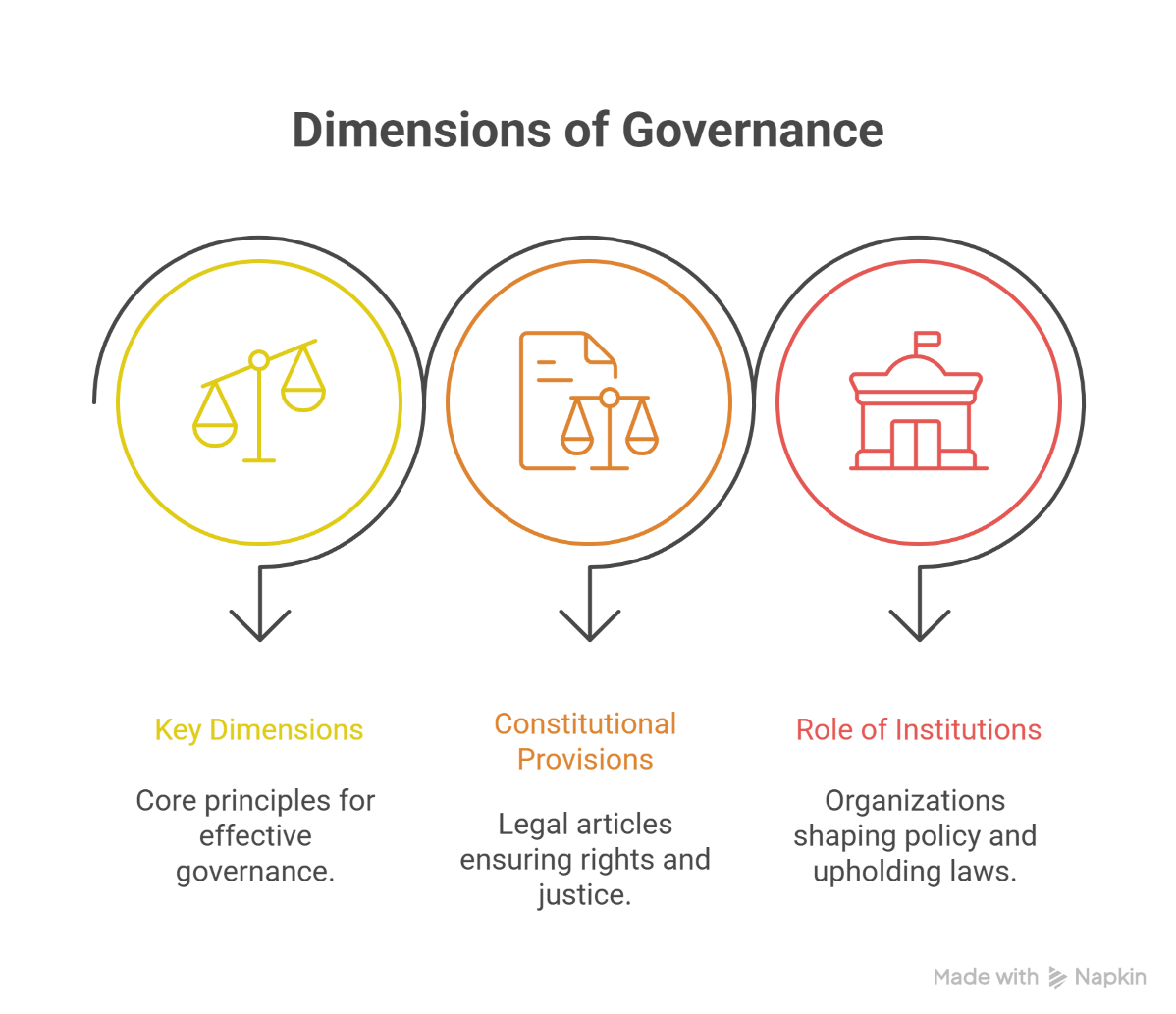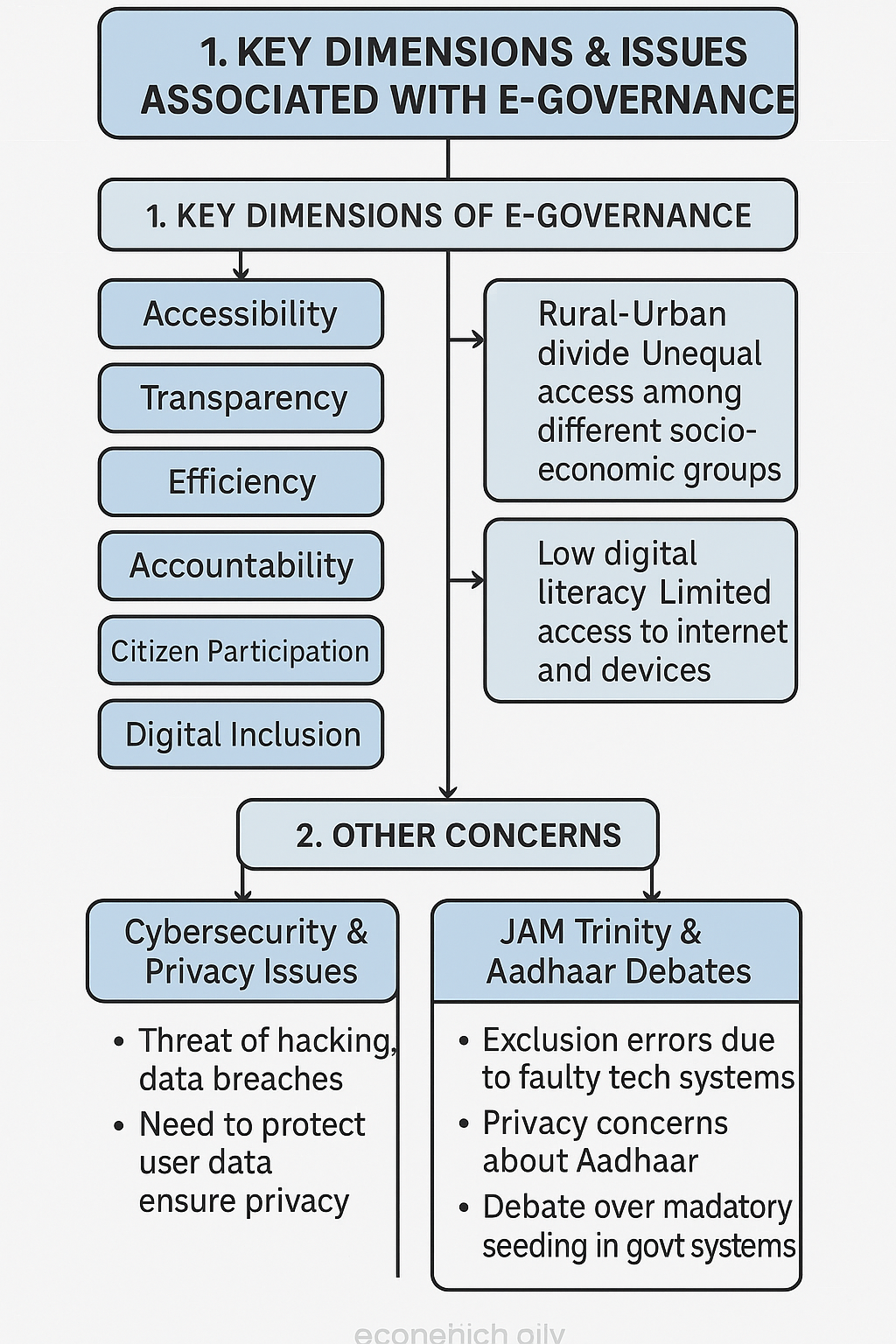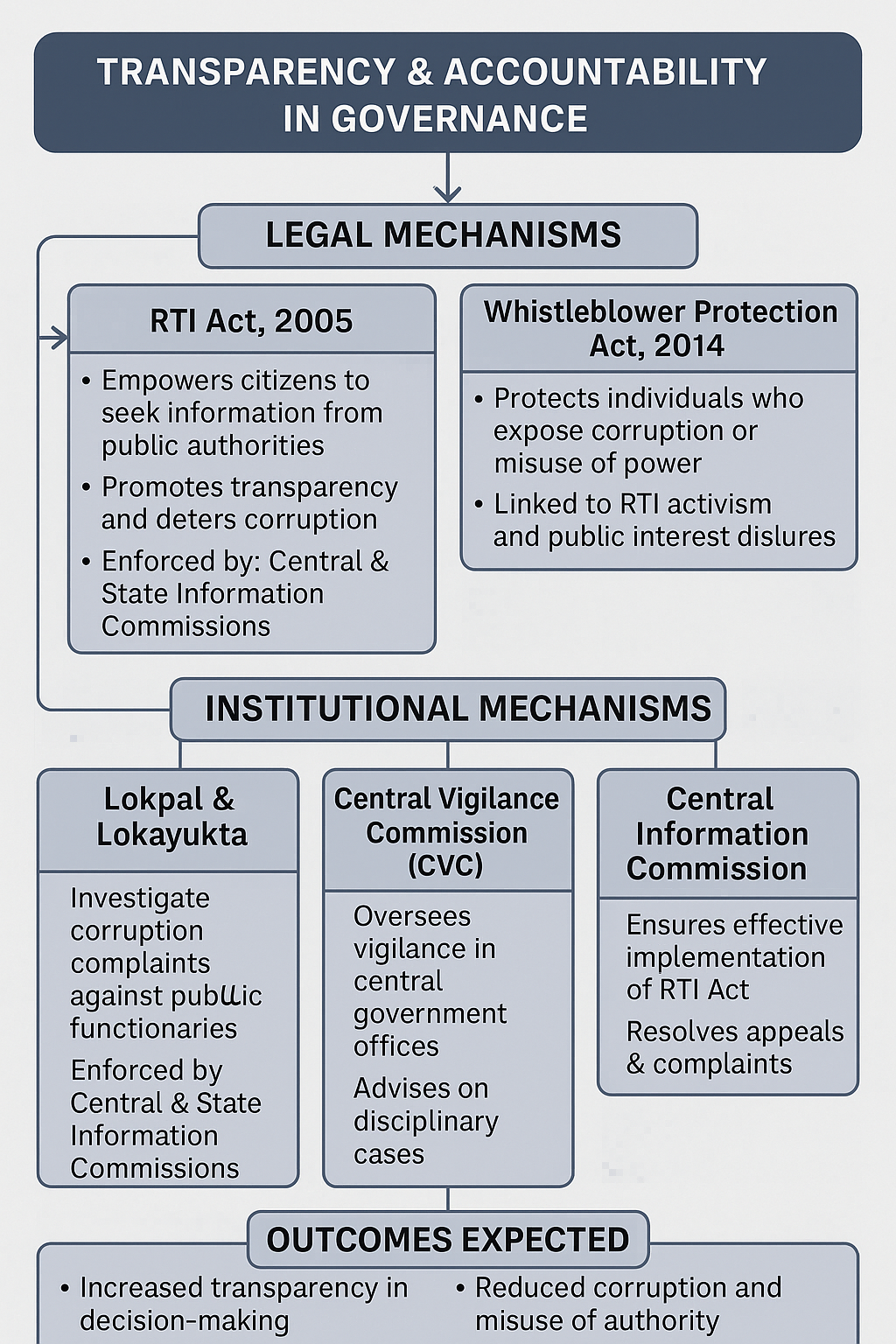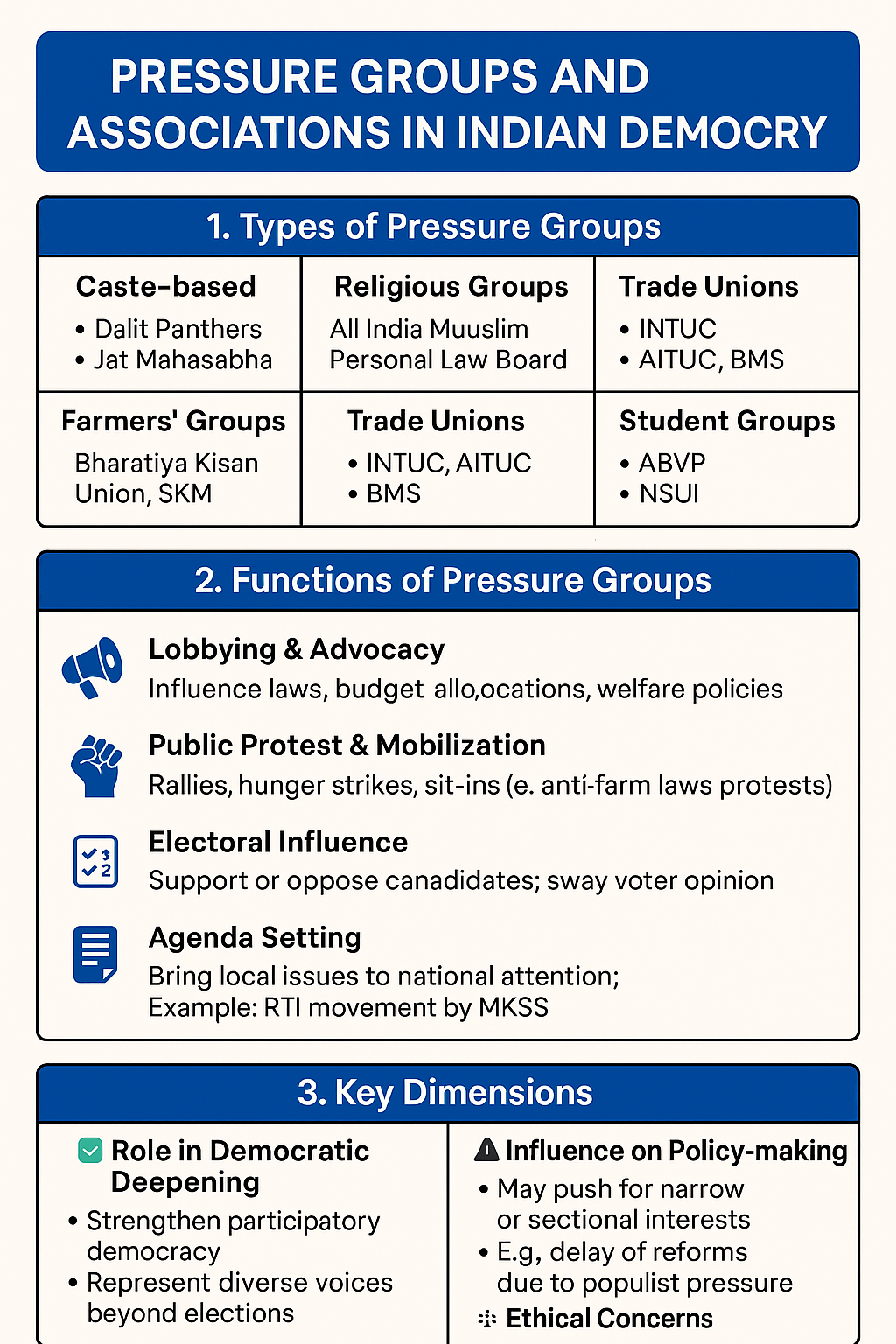🟨 GOVERNANCE: Meaning & Scope
→ Meaning:
✓ Process of decision-making and implementation
✓ Emphasizes accountability, transparency, participation, rule of law
→ Scope Includes:
• Public institutions & procedures
• Civil society & private sector roles
• Policy formulation and service delivery
🟨 GOVERNANCE vs GOVERNMENT
Government | Governance |
Structure of authority (Executive, Legislature, Judiciary) | Process of exercising authority |
Institution-based | Process-based |
More rigid | More flexible, dynamic |
Focus: Rules, control | Focus: Outcomes, participation |
🟨 EVOLUTION: Administration → Governance → Good Governance
1. Traditional Administration
↓
2. Shift to Governance – Inclusion of non-state actors, decentralization
↓
3. Good Governance – Responsive, transparent, inclusive, accountable governance (World Bank, UNDP models)
🟨 TYPES OF GOVERNANCE
→ Democratic Governance
• Citizens’ participation
• Rule of law, elections, accountability
→ Corporate Governance
• Ethical management of corporations
• Transparency, board responsibility, shareholder rights
→ E-Governance
• ICT-based delivery of public services
• Enhances efficiency, access, reduces corruption

🟦 GOOD GOVERNANCE
🔷 Characteristics of Good Governance
- Efficiency
• Optimal use of resources
• Timely service delivery - Inclusiveness
• Participation of all sections
• Equity & social justice - Responsiveness
• Addressing citizens’ needs quickly
• People-centric policies
Other key features:
• Accountability
• Transparency
• Rule of law
• Consensus-oriented
• Participation
📊 Good Governance Index (GGI) – By DARPG
Purpose:
✓ To assess the state of governance in Indian states & UTs
Framework:
• 10 Sectors (e.g., Health, Agriculture, Judiciary, etc.)
• 58 Indicators
Classification:
• Group A: 10 North & Hill States
• Group B: 9 Southern & Coastal States
• Group C: 7 NE States
• Group D: UTs
🛠️ Government Initiatives Promoting Good Governance
- RTI Act (2005)
• Promotes transparency
• Empowers citizens to demand information - Sevottam Model
• Service delivery excellence framework
• Includes Citizen Charters, Public Grievance Redress, Service Quality Monitoring
3. E-Governance
• ICT-enabled governance
• Examples: UMANG, DigiLocker, MyGov, e-District

🟦 E-GOVERNANCE
🔹 Definition
Use of ICT (Information & Communication Technology) for:
• Delivering government services
• Enhancing transparency, efficiency & accountability
• Promoting citizen participation
🔸 Components of E-Governance
Acronym | Full Form | Example |
G2G | Government to Government | e-Office, NICNET |
G2C | Government to Citizen | UMANG, DigiLocker |
G2B | Government to Business | GST Portal, MCA21 |
G2E | Government to Employee | SPARSH, eHRMS |
🔹 National e-Governance Plan (NeGP)
Launched: 2006
Aim: “Make all government services accessible to the common man in his locality.”
Structure:
• 31 Mission Mode Projects (MMPs)
• Core infrastructure: CSCs, SWANs, SDCs
🔹 Digital India Mission (2015)
Vision: Transform India into a digitally empowered society & knowledge economy
Pillars:
- Digital Infrastructure as Utility
- Governance & Services on Demand
- Digital Empowerment of Citizens
🧩 Key E-Governance Platforms
• UMANG – Unified access to govt services
• CoWIN – COVID vaccination portal
• DigiLocker – Secure cloud-based document storage
• MyGov – Citizen engagement platform
• e-SHRAM – National database of unorganized workers

🟦 ROLE OF CIVIL SERVICES IN DEMOCRACY
🔹 1. Core Roles
→ Policy Implementation
• Translates laws and schemes into action
• Example: Mid-Day Meal, PMAY-G
→ Administrative Stability
• Continuity across changing governments
• Permanent executive backbone
→ Public Service Delivery
• Ensures welfare schemes reach the last mile
• Grievance redress, citizen interface
→ Advisory Role
• Aids ministers with evidence-based inputs
• Drafting policies and white papers
→ Crisis & Disaster Management
• Coordinates relief in pandemics, floods, etc.
🔹 2. Foundational Values
Value | Description |
Neutrality | Non-partisan execution of government decisions |
Integrity | Honesty and ethical conduct |
Empathy | Understanding citizens’ needs, especially the marginalized |
Responsiveness | Timely service delivery, listening to feedback |
Accountability | Answerable to people and Parliament |
🔹 3. Reforms in Civil Services
→ Mission Karmayogi
• Capacity-building programme (2020)
• Shift from rule-based to role-based governance
• Focus: Competency-driven training
→ Lateral Entry
• Inducts domain experts into middle/senior ranks
• Infuses specialized knowledge
• Controversy: merit vs neutrality

🟦 Transparency & Accountability Framework in India
🔹 1. Legal Mechanisms
✅ RTI Act, 2005
- Empowers citizens to seek information from public authorities
• Promotes transparency and deters corruption
• Enforced by: Central & State Information Commissions
✅ Whistleblower Protection Act, 2014
- Protects individuals who expose corruption or misuse of power
• Ensures identity protection and safeguards against victimization
• Linked to RTI activism and public interest disclosures
🔹 2. Institutional Mechanisms
Institution | Role |
Lokpal & Lokayukta | Investigate corruption complaints against public functionaries (Centre & State) |
Central Vigilance Commission (CVC) | Oversees vigilance in central government offices; advises on disciplinary cases |
Central Information Commission (CIC) | Ensures effective implementation of RTI Act; resolves appeals & complaints |
🔹 3. Outcomes Expected
→ Increased transparency in decision-making
→ Reduced corruption and misuse of authority
→ Empowered citizenry & participatory governance
→ Strengthened institutional checks and balances

🟦 CITIZEN CHARTERS & GRIEVANCE REDRESSAL
🔹 1. Key Components of a Citizen Charter
- Service Standards
→ Clearly defined services, timelines, and procedures
→ Example: Passport issuance in 3–7 working days - Grievance Redressal Mechanism
→ Defined complaint-handling process
→ Escalation matrix and response timelines - Accountability Measures
→ Responsibility assigned to officials
→ Monitoring through feedback loops
🔹 2. Case Studies & Initiatives
Initiative | Highlights |
Passport Seva Project | Online application, real-time tracking, timeline-bound services |
Indian Railways | Passenger charter, refund timelines, complaint resolution apps |
CPGRAMS | Centralized grievance redress portal for all ministries/depts |
🔹 3. Key Dimensions & Issues
- Implementation Gap
→ Charters not properly followed or updated
→ Tokenism without real accountability - Public Awareness
→ Citizens unaware of their service rights
→ Low usage of grievance platforms
• Legal Enforceability
→ Charters are not legally binding
→ No penalty for non-compliance
🟦 SOCIAL AUDIT
🔹 1. Concept
→ What:
A participatory process where citizens review and evaluate the planning and implementation of government schemes.
→ Why:
• Ensures transparency and accountability
• Promotes community participation
• Identifies gaps, misuse, and leakage of funds
→ How:
• Conducted by gram sabhas, NGOs, or civil society
• Accessing official records, physical verification, and public hearings
• Followed by Social Audit Reports
🔹 2. Applications in Flagship Schemes
Scheme | Role of Social Audit |
MGNREGA | Mandatory under law, monitors worksite conditions, wage delays |
PDS | Detects diversion of food grains, fake ration cards |
Mid-Day Meal | Monitors food quality, attendance, utilization of funds |
🔹 3. Role of Civil Society
- Trains local people for audits
• Mobilizes participation
• Acts as watchdog against corruption
• Builds community ownership
🔹 4. Key Dimensions & Challenges
- Resistance from Bureaucracy
→ Lack of cooperation, manipulation of records - Lack of Awareness
→ Citizens unaware of their right to audit - Legal Status & Effectiveness
→ Legal backing only in limited schemes like MGNREGA
→ Often symbolic without punitive powers
Role of NGOs, SHGs & Civil Society in Governance
🟦 1. Key Roles in Governance
🔹 Policy Advocacy
- Voice for marginalized groups
• Participatory policy formulation
• Example: PRS Legislative Research, MKSS
🔹 Service Delivery
- Education, health, nutrition, disaster relief
• Complement state capacity
• Example: Akshaya Patra (Mid-Day Meal), SEWA
🔹 Awareness & Mobilization
- Legal literacy, RTI campaigns, women’s rights
• Grassroots activism
• Example: Robin Hood Army, SHGs under NRLM
🟦 2. Legal & Institutional Framework
Law / Platform | Description |
FCRA (2010) | Regulates foreign funding to NGOs; ensures national interest |
NGO-DARPAN (NITI Aayog) | Database of registered NGOs; improves transparency |
Societies & Trust Acts | Legal registration for operational legitimacy |
🟦 3. Key Challenges
- Transparency & Accountability Issues
→ Misuse of funds, lack of audits - Funding Constraints
→ Tightened FCRA norms, donor dependence
• Overregulation & Bureaucratic Delays
→ License cancellations, undue scrutiny

Rights-Based Governance in India
(Important for UPSC Mains – Governance + Polity)
🟦 1. Core Concept: Rights-Based Approach
- Treats citizens as rights-holders
• Makes the State duty-bound to deliver basic entitlements
• Focus: Dignity, equity, empowerment, and legal enforceability
🟦 2. Key Legislations under Rights-Based Governance
Right | Act / Provision |
Right to Information | RTI Act, 2005 – Ensures transparency & accountability |
Right to Education | RTE Act, 2009 – Free & compulsory education (6–14 years) |
Right to Food | NFSA, 2013 – Legal guarantee to subsidized food grains |
Right to Health | Evolving via Supreme Court directives + schemes like Ayushman Bharat |
🟦 3. Role of Judiciary
- Enforced socio-economic rights under Article 21
→ PUCL Case (2001) – Right to Food
→ Unnikrishnan Case (1993) – Right to Education
→ Puttaswamy Case (2017) – Right to Privacy - Catalyzed policy action via PILs
• Balanced rights vs. resource constraints
🟦 4. Rights vs. Entitlements
Rights | Entitlements |
Legal claim enforceable in court | Policy-based benefits |
Rights imply accountability | Entitlements may lack enforceability |
🟦 5. Key Dimensions & Challenges
• Implementation Gaps – Poor infrastructure, lack of awareness
• Data Outcomes – Low literacy, malnutrition, healthcare access issues
• Policy–Judiciary Synergy – Sometimes friction, sometimes convergence (e.g., SC on migrant workers’ welfare during COVID)

